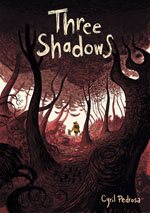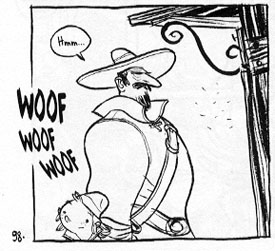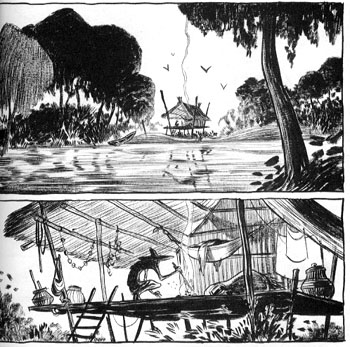 By Cyril Pedrosa
By Cyril Pedrosa
272 pages, black and white
Published by First Second Books
Reading Cyril Pedrosa’s Three Shadows, I couldn’t help but think about the brief author’s biography provided in the end-flaps of the graphic novel. In it is the mention that Pedrosa was inspired to create the book after watching close friends lose a young child. It seems like a particularly grim thing to put up front, but at the same time I think it’s actually the smart thing to do. Providing context for this story makes what might feel like an overly long book instead makes its padding work in its favor.
Louis and Lise live a happy life with their young son Joachim. Everything seems perfect until the evening where Joachim wakes up, unable to sleep because of the three shadows on the hill. At first his parents laugh, until they see three dark-shrouded figures riding on horses, off on the hill. Or rather, until they see the horsemen over and over again. What had once seemed normal is now anything but, as Louis and Lise realize that these shadows are stalking their child, watching and waiting. Desperate to escape, Louis takes Joachim away from home—but how far will Louis go to try and save his son?
 Viewed strictly as a creepy adventure story, Three Shadows is good but a little overly long. Once the chase begins, Pedrosa takes his characters into a number of new and dangerous settings; the problem is, it feels like a little too much. One quickly gets the basic message, that there is nothing that Louis won’t do to protect his son. It’s an admirable message, and very understandable. But how often does one need to hear the message? When Louis and Joachim set out on an adventure to cross the vast river that separates their home from Louis’s homeland, the change in scenery and situation is interesting. But afterwards, it just feels like too much, from the bayou to the tundra to the city. Honestly, the story itself slightly overstays its welcome, and I can see it making readers more than a little fidgety.
Viewed strictly as a creepy adventure story, Three Shadows is good but a little overly long. Once the chase begins, Pedrosa takes his characters into a number of new and dangerous settings; the problem is, it feels like a little too much. One quickly gets the basic message, that there is nothing that Louis won’t do to protect his son. It’s an admirable message, and very understandable. But how often does one need to hear the message? When Louis and Joachim set out on an adventure to cross the vast river that separates their home from Louis’s homeland, the change in scenery and situation is interesting. But afterwards, it just feels like too much, from the bayou to the tundra to the city. Honestly, the story itself slightly overstays its welcome, and I can see it making readers more than a little fidgety.
At the same time, though, it’s hard to avoid the book’s connection to the real events that Pedrosa saw. When you view it that way, it’s a little easier to accept the book’s slightly-too-long length, because it seems almost like that’s the point that Pedrosa is also trying to make. Even beyond the point where one should give up, parents will fight onwards to try and save their children, no matter what. It’s a strong, narrowly focused emotional core to the book and it made me think of Three Shadows in a slightly different way. It does mean that some of the comic relief towards the end of the book (in the city, with the three shadows pursuing their prey) feels a little misplaced when you think about it, but overall it’s additional knowledge that seems almost integral to the Three Shadows experience.
 On the other hand, I’d take a 500-page edition of Three Shadows strictly for hundreds of additional pages of Pedrosa’s amazing art. It’s beautiful, using handfuls of curved thin lines to create drawings that really don’t look quite like anything else I’ve seen in comics. They’ve got a strong sense of grace and beauty to them, and it’s easy to to see Pedrosa’s animation background in their creations. Pedrosa shows a vast range of styles in Three Shadows as well, breaking away from his chosen look for the bulk of the book when appropriate. From thick brush strokes only giving vague outlines to their forms when Louis and Joachim leave home, to the heavy shading and charcoal smears upon Louis meeting the slave chained up in the captain’s cabin, to the usage of a scratchboard for a limited photo-negative effect for the view of the underworld, each shift in visuals is startling and amazingly effective. I’ve often said that I don’t pick up graphic novels in other languages because I would rapidly become penniless, but I might just have to make an exception if it means getting ahold of more of Pedrosa’s gorgeous art.
On the other hand, I’d take a 500-page edition of Three Shadows strictly for hundreds of additional pages of Pedrosa’s amazing art. It’s beautiful, using handfuls of curved thin lines to create drawings that really don’t look quite like anything else I’ve seen in comics. They’ve got a strong sense of grace and beauty to them, and it’s easy to to see Pedrosa’s animation background in their creations. Pedrosa shows a vast range of styles in Three Shadows as well, breaking away from his chosen look for the bulk of the book when appropriate. From thick brush strokes only giving vague outlines to their forms when Louis and Joachim leave home, to the heavy shading and charcoal smears upon Louis meeting the slave chained up in the captain’s cabin, to the usage of a scratchboard for a limited photo-negative effect for the view of the underworld, each shift in visuals is startling and amazingly effective. I’ve often said that I don’t pick up graphic novels in other languages because I would rapidly become penniless, but I might just have to make an exception if it means getting ahold of more of Pedrosa’s gorgeous art.
In the end, Three Shadows worked for me, but I’ll admit that it’s not a completely perfect book. Other readers might not be as forgiving of the book’s slightly bloated length, but for me I found myself in the end willing to accept it to help make Pedrosa’s point. And, as said before, his art is so amazing that in that sense alone it was well worth the additional pages. The one thing I know for certain is that if First Second (or any other publisher) brings more of Pedrosa’s work into English, I will absolutely be taking a look. Pedrosa’s art is simply stunning, and for that alone it demands your attention.
Purchase Links: Amazon.com
